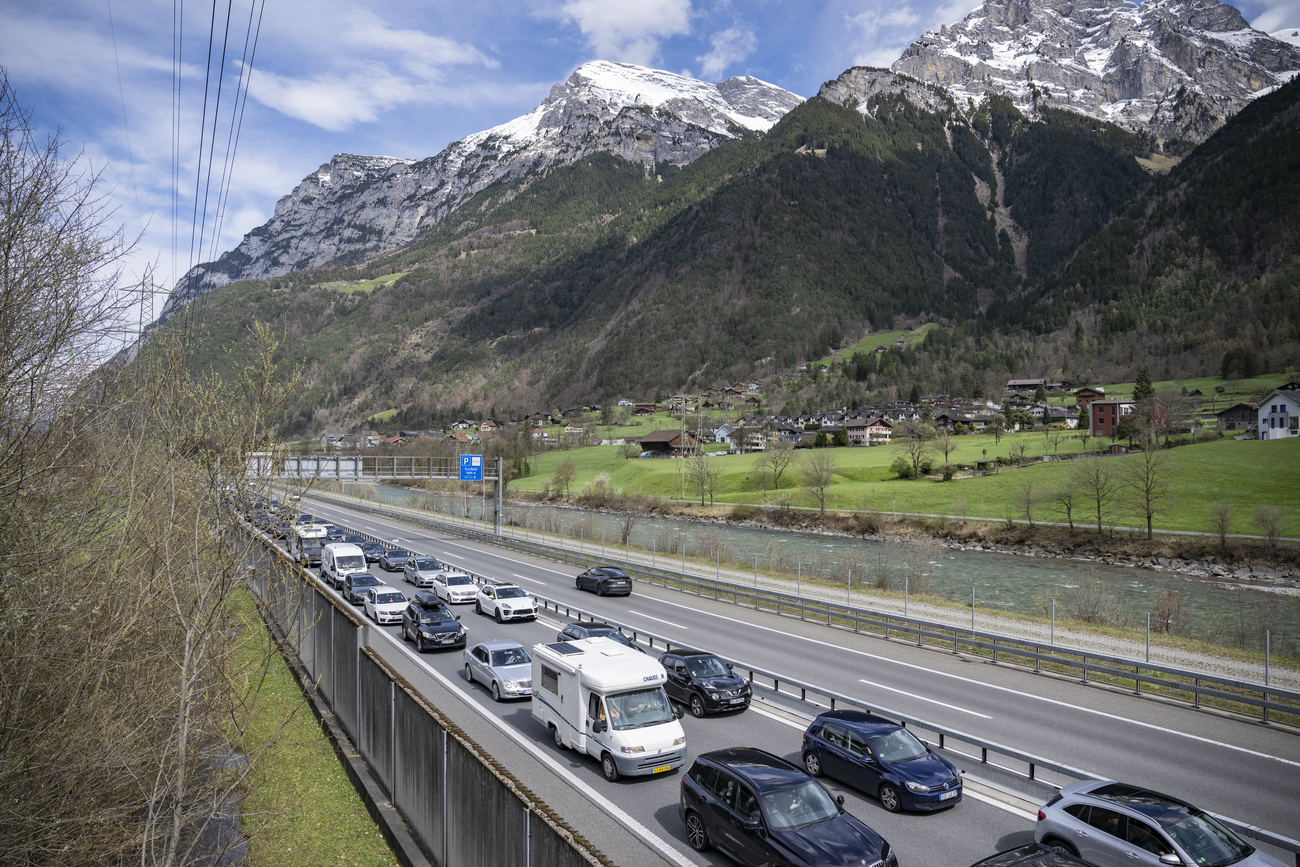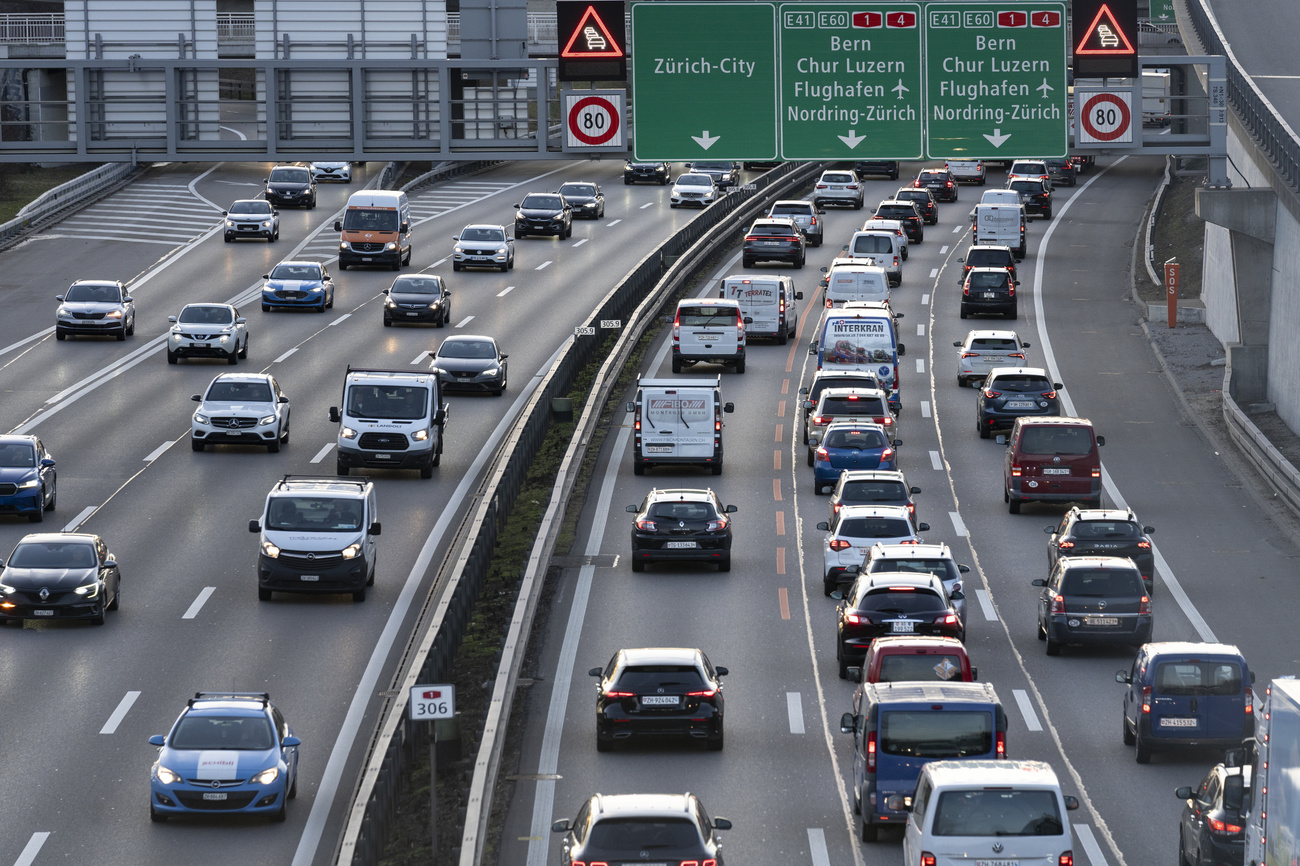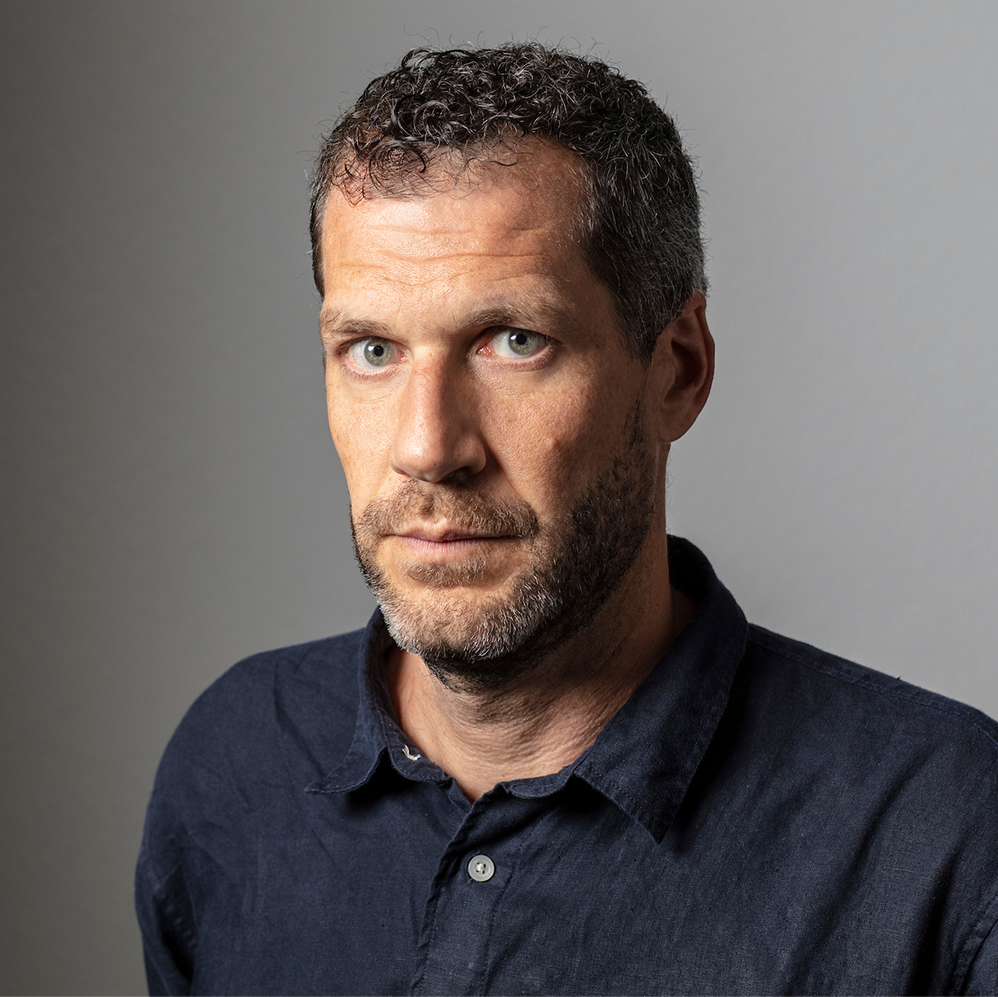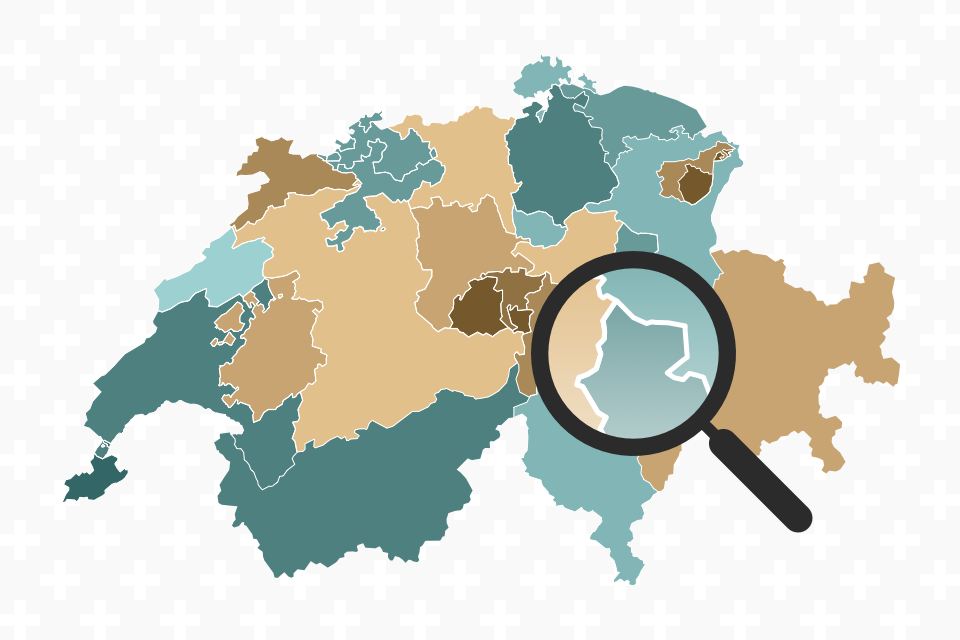Why cars still reign supreme in ‘rail-nation’ Switzerland

With the population’s growing need for mobility, some Swiss motorways are nearing saturation point. Nearly 50,000 hours were lost in traffic jams last year. But infrastructure is not the root of the problem, experts say.
On November 24, Swiss voters will decide on the biggest motorway project in recent decades.
The government wants to widen several existing motorway sections in order to eliminate bottlenecks. These build up especially on the A1, Switzerland’s longest motorway, which crosses the country from east to west. Advocates of greener mobility vehemently oppose the plan.
Read here to discover the arguments of those in favour of and those against the project.
Congestion problems and the future of mobility are issues besetting many countries, which is why we have sought to place the Swiss situation in an international context.
Are the Swiss motorways victims of their success? Despite a marked slowdown during the Covid pandemic, the number of vehicles plying Switzerland’s main arteries continues to rise.
In its annual reportExternal link on traffic on national roads (see box for definition), the Federal Roads Office (FEDRO) reported that nearly 30 billion kilometres were travelled on the network last year. This is up 1.5% from 2022 – and 130% more than in 1990. Almost half of all the country’s traffic goes along these major routes, although they represent just 3% of the road network in terms of kilometres.
Responsibility for road infrastructure in Switzerland is split between the federal, cantonal and municipal authorities.
The federal government manages what are known as national roads. These are major arteries of national importance, mainly motorways (with four or more lanes) and expressways (with two to three lanes). They link the different regions to each other and Switzerland to the rest of Europe, as well as providing bypasses around populated areas.
Today Switzerland has just over 2,250km of national roads, including 1,550km of motorwaysExternal link and 440km of expressways.
Demographic growth is just part of the explanation, as motorway traffic has grown much faster than the population over the past 30 years. “The increase in economic activity is another factor,” says Lorenzo Quolantoni, head of communications at FEDRO. “People’s mobility needs have increased, whether for leisure or business purposes.”
Alexis Gumy is an associate researcher at the Laboratory of Urban SociologyExternal link of the Swiss Federal Institute of Technology LausanneExternal link (EPFL). He believes the surge in individual traffic is in part due to a “dependence on commuting”, as people live ever further from their work, mainly as a result of the worsening housing crisis in the cities.
Lifestyles have also changed since Covid, Gumy explains, contributing to an increase in road traffic. Home deliveries, which soared during the pandemic, have now become an established practice for many people. Between 2019 and 2023, e-commerce sales in Switzerland rose by over 40%External link. Meanwhile, teleworking is less prevalent today than it was during the health crisis.
Record traffic jams This heavy traffic has led to exponential congestion problems. In 2023, the overall duration of traffic jams rose by 22% compared with the previous year, reaching nearly 49,000 hours – a record, according to FEDRO.
Most of the blockages are caused not by accidents or roadworks but by sheer volume of traffic, and their total duration is increasing faster than the number of vehicles. For FEDRO this is proof that “the network has reached saturation point”. “The slightest disruption has a major impact on traffic flow,” Quolantoni says.
Traffic builds up in particular around the major cities, especially on the A1. This nearly 400km-long motorway runs from Geneva in the west to Switzerland’s eastern border, linking the conurbations of Lausanne, Bern and Zurich. Another blackspot is the A2, which stretches from the German border in the north to the Italian border in the south. The main sticking point is the entrance to the Gotthard tunnel, where long tailbacks form – no longer just during holiday periods.
Other motorway stretches that are heavily used by cross-border commuters, such as the A24 in canton Ticino on the way to Italy and the A20 between canton Neuchâtel and France, have the most “intensive” traffic jams, in that they last particularly long compared to the distance travelled.
While these problems are common to most urban areas around the globe, several Swiss cities feature highly in the latest ranking of the world’s most congested citiesExternal link, drawn up by GPS technology giant TomTom.
According to calculations by the Federal OfficeExternal link for Spatial Development, in 2019 traffic jams in Switzerland resulted in nearly 73 million hours of lost time, with an estimated economic value of around CHF3 billion ($3.5 billion). Congestion also has a “harmful impact on people and the environment (diversion onto alternative routes, greater safety risks, increased emissions and noise pollution, etc.)”, Quolantoni says.
A ‘luxury’ motorway network
Over the past 15 years, European motorways have been extended by over 70% on average, according to the United Nations Economic Commission for Europe (UNECEExternal link), albeit with major disparities between countries.
The Swiss network, which was planned in the 1960s and progressively built, has been extended by “only” 14% since 2005. It is now “98% complete”, Quolantoni says, pointing out that the projects being put to the vote in November will not extend the network but rather widen certain existing sections.
Compared to the country’s population and surface area, however, the Swiss motorway network is dense and, taking into account the mountainous topography, it serves all the regionsExternal link and main towns. More than 20 different sections of motorway criss-cross the country from east to west and north to south. There is also a “very high number” of motorway junctions – nearly 500 overall – which, Quolantoni says, gives drivers quick access to the nearest motorway entrance and helps “reduce traffic in inhabited areas”.
Anastasios Kouvelas, meanwhile, is convinced that “Switzerland has sufficient motorway capacity”. He is the director of traffic engineering at the Institute for Transport Planning and SystemsExternal link of the federal technology institute ETH Zurich. Urban sociologist Gumy at EPFL also points out that easy access to a good motorway network encourages people to commute, which “of course, does not help traffic flow”.
Switzerland allocates considerable resources to its motorways. In 2021, it spent over CHF2 billion on motorway investmentExternal links, the largest amount of any OECD countryExternal link for which comparable data is available. Switzerland is also one of the countries that spent the most on maintenance (over CHF300 million).
“Compared with other countries, the Swiss motorways have a large number of bridges, flyovers and tunnels,” Quolantoni explains. “The national road network is thus very complex and requires extensive maintenance works” – which also increasingly disrupt traffic flow.
The car still reigns supreme
Switzerland is known as one of the countries where people take the train most, and the proportion of journeys made by car is lower than the European average. Yet the car is still by far the main mode of transport, especially for everyday trips.
Carless households are a minority: 80% of External linkhouseholds own at least one car, compared with 85% in France and 62% in Denmark. The number of cars has risen steadily over the last few decades and has now reached nearly 4.8 million, or around 540 per 1,000 inhabitants, which is close to the European averageExternal link.
Although Switzerland has no car-manufacturing tradition, “the myth of the car” and the “normality” of car ownership persist, Gumy says. “The car is still associated with a form of freedom, with people still seeing it as a precondition for economic success.”
What’s more, the car is often perceived as the most affordable means of transport, whereas in reality it is the most expensiveExternal link, both for users and for communities, when all the costs are taken into account.
“Use of the Swiss motorway infrastructure is certainly not very expensive compared with other countries,” Gumy adds. The Swiss toll sticker, or vignette, allows year-long unlimited use of the entire network for CHF40. This is less than in other countries with a similar system, and less than in many others that charge according to the distance travelled.
Meanwhile, “sustainable mobility is expensive, and not everyone can afford it”, Gumy says. In September, the official Swiss price watchdog expressed indignation at the “huge gapExternal link” between the price of public transport in Switzerland, which has almost doubled since the 1990s, and the car, which has remained relatively stable.
The whole matter is also important from an environmental point of view. Although per capita greenhouse gas emissions from road transport have fallen in Switzerland over the past 30 years, they still account for nearly a third of total emissions, which the country has committed to reducing in line with the Paris Agreements.

More
Electric cars stall in Switzerland
So is increasing motorway capacity the solution?
All of this helps put more and more cars on the roads and exacerbate bottlenecks, which can be alleviated only by “targeted widening”, the authorities say. But is this really the solution? Many experts – including those interviewed by SWI swissinfo.ch – do not agree.
The opposite could even happen in a few years, in accordance with the principle of “induced demand”. Numerous studies carried out in different cities (summarised in this reviewExternal link in French from 2012 and this more recent oneExternal link in English) have shown that increasing network capacity does indeed relieve congestion, but only in the short term – for about two to five years. One reason for this is that the possibility of getting around easily by car tends to encourage “latent” users to get behind the wheel.
“In general, after ten years, we’re back to a situation of congestion – but with 40,000 more vehicles than before, which is the capacity of a new motorway lane,” Gumy says. This traffic, Kouvelas adds, is destined to spill over onto the rest of the network, causing jams elsewhere, particularly at motorway exits.
FEDRO does not deny that traffic will increase on the motorways if the expansion work goes ahead. But this will not be new traffic, Quolantoni says. It is “just a matter of bringing back onto the motorways the vehicle flow” that has been pushed onto secondary roads because of the current saturation.
According to FEDRO, road widening does work, as illustrated by the third Gubrist tunnel, on Zurich’s northern bypass. According to the office’s spokesman, “traffic has been flowing more smoothly there since [it] opened in August 2023”.
There are very few older examples of motorway widening in Switzerland. However, there is the case of the Baregg Tunnel, between cantons Aargau and Zurich. The jams effectively disappeared when it was widened in 2003; but 20 years on it is once more a major snarl-up on the motorway network.
More
So what are the solutions, given that demand for mobility will only increase? Road infrastructure optimisation specialist Kouvelas believes smart technologies could be put to better use to “monitor the infrastructure and respond proactively when traffic builds up”, for instance by opening motorway lanes going the other way. Some methods, he explains, such as repurposing hard-shoulders and adapting speed limits in line with traffic conditions, are already being used in some places in Switzerland, although much less than in Germany.
Other approaches would involve influencing demand, for instance by promoting other forms of transport, in particular collective ones (carpooling, public transport), and encouraging traffic during off-peak hours.
In any case, congestion problems can be reduced only marginally by infrastructure, Gumy concludes, because “they have structural roots”. “They are above all a sign that it’s time to think of something else,” he adds. “And if road traffic flows smoothly again one day, it will be because we’ve made great progress on other forms of mobility.”

More
Voters to decide on major Swiss motorway expansion
Edited by Samuel Jaberg. Adapted from French by Julia Bassam/ts

In compliance with the JTI standards
More: SWI swissinfo.ch certified by the Journalism Trust Initiative











You can find an overview of ongoing debates with our journalists here . Please join us!
If you want to start a conversation about a topic raised in this article or want to report factual errors, email us at english@swissinfo.ch.